
Sea Level Rise Accelerating For US East Coast

CHARLOTTE, N.C. — This summer the North Carolina Senate passed a bill banning researchers from reporting predicted increases in the rate of sea level rise. But the ocean, unbound by legislation, is rising anyway — and in North Carolina this rise is accelerating, researchers reported here yesterday (Nov. 6) at the annual meeting of the Geological Society of America.
On the coast of North Carolina and at other so-called "hotspots" along the U.S. East Coast, sea levels are rising about three times more quickly on average than they are globally, researchers reported during a session devoted to sea level rise.
That's the fastest rise in the world.
"What we're seeing here is unique," said Asbury Sallenger, an oceanographer at the U.S. Geological Survey in St. Petersburg, Fla.
The accelerating rise
And this rise is accelerating, said Tal Ezer, a researcher at Old Dominion University in Norfolk, Va.
His colleague, Larry Atkinson, said computer models suggest that if this acceleration continues at the same pace, the rise along the East Coast — from North Carolina to Massachusetts — could be 5.3 feet (1.6 meters) by 2100.
Sign up for the Live Science daily newsletter now
Get the world’s most fascinating discoveries delivered straight to your inbox.
Sea levels on this stretch of land have climbed as much as 1.5 inches (3.7 centimeters) per decade since 1980, while globally they've risen up to 0.4 inches (1.0 cm) per decade, according to a study by Sallenger published in June.
Why is the rise accelerating? Researchers said it's due in part to the sinking of land in the mid-Atlantic, a process called subsidence. Also, warming oceans have decreased the flow rate of the Gulf Stream, a current that ferries warm water from the Caribbean and Gulf of Mexico northeast across the Atlantic. With a less intense Gulf Stream, water is backed up toward the shore, causing sea level rise. Differences in coastal geography, temperature and salinity (salt content) cause different rates of rise along the East Coast, Atkinson said.
Sea levels worldwide are rising due to melting of glaciers in the Arctic and Antarctic, as well as expansion of water caused by heating, researchers said. [8 Ways Global Warming Is Already Changing the World]
All too vulnerable
Although the original bill by the North Carolina Senate was rejected by the state House of Representatives in June following international outcry, a compromise was reached that bans state agencies from making plans or laws based on exponential extrapolations of sea level rise for the next three to four years, according to local news reports.
North Carolina lawmakers were the butt of jokes at this session on sea level rise, but underlying the humor was a sense of anxiety, even desperation.
One session titled "Does acceleration matter?" concluded that yes, of course it does, but current efforts to deal with the problem are completely insufficient.
Robert Young, a scientist at Western Carolina University, said that by developing low-lying coastal areas, we are all too vulnerable to storms at current sea levels, as was made clear last week in the New York area by the devastation wrought by Hurricane Sandy.
"We cannot expect as a society to respond to accelerating sea level rise if we can't even respond to linear sea level rise and storms," he said. "Every single storm is an opportunity to take a step back from the coast. Instead, coastal development continues."
Young cited the example of Dauphin Island, Ala., which has been inundated by storms eight times in 26 years. Each time, he said, the federal government has stepped in and paid to rebuild the island's infrastructure. "That's crazy," Young said.
Some uncertainty
There is some uncertainty and disagreement between scientists about the particulars of the accelerating sea level rise. One of the biggest questions is how long this acceleration might last. Sallenger's calculations suggest it could continue for about a century, while others are less certain.
But there is no question that sea levels are rising and that this rise has significant impacts. An internal study by the Hunting Ingalls shipyard in Newport News, Va., the sole builder of nuclear-powered aircraft carriers, found that squalls capable of bringing threatening storm surges near its facility have become more common. These storms once occurred every 80 years; now they are likely to happen every two years, Atkinson said.
Sea levels are measured by tidal gauges are various points along the East Coast. One gauge at Sandy Hook, N.J., was reporting a 0.15 inch (3.9 mm) rise per year, according to the National Oceanographic and Atmospheric Administration.
But it won't be collecting any more data, said John Boon, a researcher at the Virginia Institute of Marine Science. It was destroyed by Hurricane Sandy.
This story was provided by OurAmazingPlanet, a sister site to LiveScience. Reach Douglas Main at dmain@techmedianetwork.com. Follow him on Twitter @Douglas_Main. Follow OurAmazingPlanet on Twitter @OAPlanet. We're also on Facebook and Google+.










